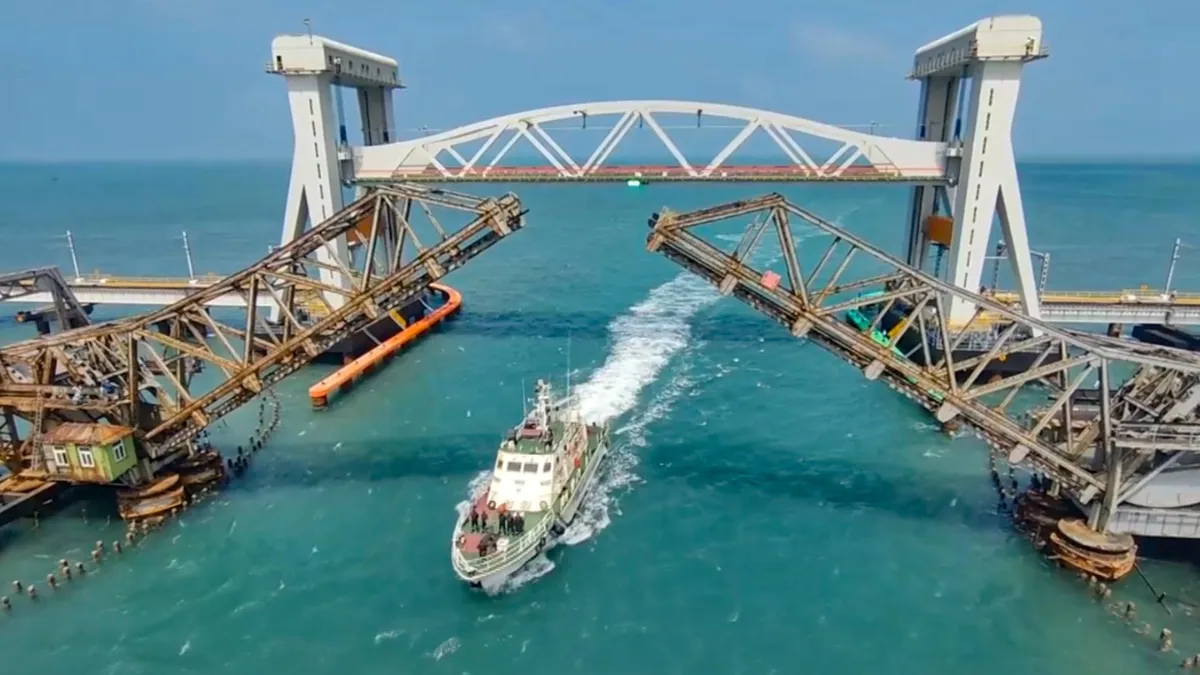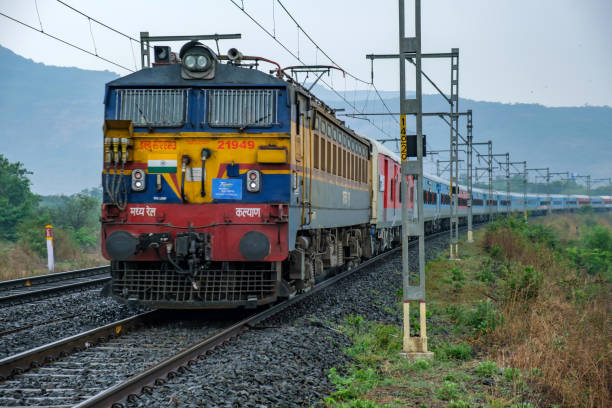Mechanism, Purpose, Features Of Pamban Bridge: India’s First Vertical Lift Railway Bridge
The bridge rises in new Pamban Bridge is made up of 100 spans. When a ship has to pass, the center span of this navigation bridge (the bridge that opens for ships) is raised.
It works on an electro-mechanical system. Because of this, its center span can be raised up to 22 meters in just 5 minutes. Only one person will be needed for this. On the other hand, the old bridge was a cantilever bridge. It was opened manually through a lever, which required 14 people.
However, when the sea breeze speed reaches 58 kmph or more, the vertical system will not work, and an automatic red signal will be given. Train movement will remain closed until the wind speed becomes normal. This often happens between October and February. Strong winds blow during these months.
How does the mechanism of the bridge work?
The mechanism of the vertical lift bridge works on a balancing system. Counterweights have been installed in it. When the bridge rises, both the span and the counterweight get support with the help of shives big wheels.
When the bridge comes down, counterweights support its weight. Due to this technology, the bridge can bear more weight. This makes the vertical lifting of the center span of the bridge smooth and safe.
Train trial has been done on the bridge
Southern Railway conducted a light engine trial run on the new Pamban Bridge on 12 July 2024. This trial confirmed the strength and safety of the bridge. After this, a tower car trial run was conducted on 4 August 2024, in which the OHE (overhead equipment) tower car was run till Rameswaram station.
On 31 January 2025, a successful trial of the Rameswaram Express train took place. The train was taken from Mandapam to Rameswaram station. During this, the vertical lift bridge was raised for the first time for the patrolling boat of the Indian Coast Guard.
The Commissioner of Railway Safety (CRS) has approved a speed limit of 75 kmph for the bridge, but this rule will not apply to the middle portion of the bridge, the elevated portion. 50 kmph has been allowed for the lifted portion.
The new Pamban Bridge underwent a successful trial run on 31 January 2024. The train was taken from Mandapam to Rameswaram station. CRS had found flaws in the new The CRS of Southern Railway gave an inspection report regarding the Pamban Bridge in November 2024. In this report sent to the Railway Ministry,
3 main objections were raised regarding the vertical bridge:
- The planning of the bridge was wrong. The standard design of the Research Design and Standards Organization (RDSO) was not kept in it.
- The specification of the bridge is not of RDSO but is international.
- RDSO was not involved in the execution of the design and construction of the bridge.
The Railway Ministry formed a committee of five people based on this report. Despite this, CRS had allowed train traffic on this bridge with some conditions. MP Singh, Director of Rail Vikas Nigam Limited (RVNL), who was included in the committee, said that the panel has examined all aspects of the bridge. This bridge is safe for train operation for 100 years. The train will run at a maximum speed of 75 kmph on the new Pamban Bridge.
Features of the new Pamban Bridge:
- Fully Automated Vertical Lift Span – The new bridge is equipped with a fully automated vertical lift system as compared to the old manual Scherzer lift. This will make train operations much easier.
- Ships will be able to pass at a higher height. The old bridge used to open up to a height of 19 meters, but the new bridge has an air clearance of 22 meters. This will allow large ships to pass comfortably.
- Double track and electrification – The new bridge has been designed for high-speed trains. It includes a double track and an electrified system.
- The new Pamban Bridge was to be completed by December 2021, but due to COVID-19, it was completed in 2024.
- Southern Railway had said- safe for 58 yearsIn January this year, Southern Railway shared a document saying that the robust surface protection system against corrosion can safeguard the life of the bridge up to 38 years without maintenance and 58 years with minimal maintenance.
At the same time, the old Pamban Bridge maintained rail connectivity for 108 years. It was closed in December 2022 due to rusting. It is also called ‘Cantilever Scherzer Rolling Lift Bridge’. This name was named after the German engineer Scherzer. He had designed the old bridge.
Why was there a need to build a bridge?
During the British rule, a plan was made in 1850 to build a sea route to connect India and Sri Lanka (then Ceylon). For this, the idea was to build a canal in the Palk Strait (Sethusamudram), but this plan seemed impossible due to economic and environmental reasons.
After this, the British administration prepared a new plan. Under this plan, a railway line was to be built between Mandapam and Pamban Island in Tamil Nadu, and then Dhanushkodi was to be connected to Colombo by ferry (boat).
2 main reasons for building a bridge:
- Rameswaram was important from a religious and commercial point of view. A large number of people used to come here for darshan. Boats were used for this. Traveling was difficult due to strong winds and sea waves.
- The British wanted better connectivity between Sri Lanka and Tamil Nadu so that trade with Sri Lanka could increase. For this, the British administration decided to build a railway bridge.
How was this historic Pamban Bridge built?
The plan to build the old Pamban Bridge was made in 1870, but the work started in 1911. Railway service started through this bridge on 24 February 1914. The length of this bridge was 2.06 km. It was built using special technology so that ships could pass under it.
Features of the old bridge
- The bridge was fitted with a Scherzer lift system that could raise the centre section to allow ships to pass.
- It was India’s first sea bridge and served rail services for nearly 100 years.
- Special iron was used to protect the bridge from seawater and strong winds.
- Pamban Bridge destroyed in the 1964 cyclone 23 December 1964, a cyclone with a speed of 240
- km/h severely damaged the bridge. A train also overturned, killing 150 people. Despite this devastation, the government rebuilt it in just 46 days. The responsibility of repairing it was given to E. Sreedharan.
ALSO READ: Benefits Of Cloves





